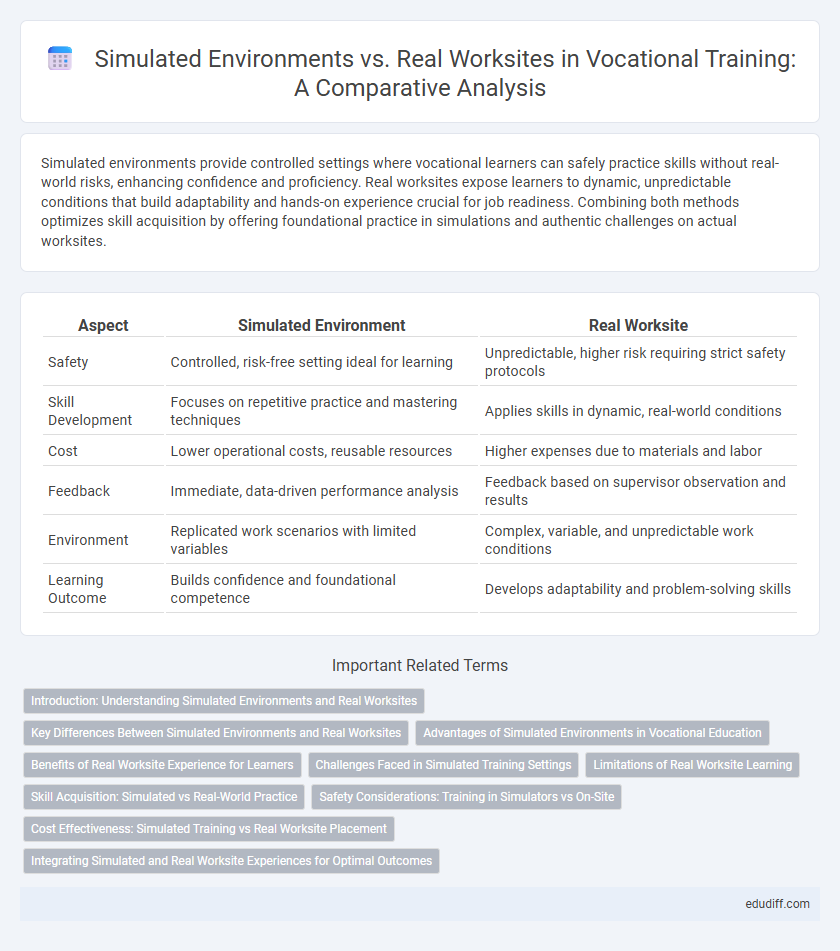Simulated environments provide controlled settings where vocational learners can safely practice skills without real-world risks, enhancing confidence and proficiency. Real worksites expose learners to dynamic, unpredictable conditions that build adaptability and hands-on experience crucial for job readiness. Combining both methods optimizes skill acquisition by offering foundational practice in simulations and authentic challenges on actual worksites.
Table of Comparison
| Aspect | Simulated Environment | Real Worksite |
|---|---|---|
| Safety | Controlled, risk-free setting ideal for learning | Unpredictable, higher risk requiring strict safety protocols |
| Skill Development | Focuses on repetitive practice and mastering techniques | Applies skills in dynamic, real-world conditions |
| Cost | Lower operational costs, reusable resources | Higher expenses due to materials and labor |
| Feedback | Immediate, data-driven performance analysis | Feedback based on supervisor observation and results |
| Environment | Replicated work scenarios with limited variables | Complex, variable, and unpredictable work conditions |
| Learning Outcome | Builds confidence and foundational competence | Develops adaptability and problem-solving skills |
Introduction: Understanding Simulated Environments and Real Worksites
Simulated environments replicate real worksites to provide safe, controlled settings for skill development and training. These virtual or physical simulations allow learners to practice tasks without the risks associated with actual worksites, improving competence and confidence. Real worksites offer authentic conditions and unpredictable challenges essential for applying learned skills in practical scenarios.
Key Differences Between Simulated Environments and Real Worksites
Simulated environments offer controlled, risk-free settings with repeatable scenarios for skill development, while real worksites expose trainees to unpredictable variables and actual work conditions. Simulations prioritize safety and standardized assessment, whereas real worksites demand real-time problem solving and adaptability to dynamic challenges. The effectiveness of vocational training depends on balancing theoretical practice in simulated environments with practical experience gained on real worksites.
Advantages of Simulated Environments in Vocational Education
Simulated environments in vocational education offer risk-free, controlled settings where learners can practice complex skills without the consequences of real-world errors, enhancing safety and confidence. These virtual or physical simulations provide repeated, standardized training opportunities that can be tailored to individual learning paces, leading to higher skill retention and mastery. Cost-efficiency and accessibility further benefit institutions by reducing the need for physical materials and allowing remote or flexible learning schedules.
Benefits of Real Worksite Experience for Learners
Real worksite experience offers learners authentic exposure to industry-specific challenges, enhancing practical skills and decision-making abilities under real conditions. Engaging directly with actual tools, materials, and workflows promotes deeper knowledge retention and adaptability, critical for vocational success. This hands-on immersion fosters professional confidence and prepares learners for immediate productivity in their chosen trades.
Challenges Faced in Simulated Training Settings
Simulated training environments in vocational education often face challenges such as limited tactile feedback and insufficient replication of unpredictable worksite conditions, which can hinder the development of critical problem-solving skills. Trainees may struggle to experience the full spectrum of hazards and pressure found in real worksites, impacting their readiness for actual job demands. Technical constraints and lack of realism in simulations can reduce engagement, making it difficult to cultivate practical expertise and situational awareness.
Limitations of Real Worksite Learning
Real worksite learning often faces limitations such as exposure to unpredictable hazards and restricted access to diverse job scenarios, which can hinder comprehensive skill development. Time constraints and safety regulations further limit hands-on opportunities, reducing the frequency and variety of practical experiences. These challenges emphasize the need for simulated environments to provide controlled, repeatable, and varied training conditions essential for vocational proficiency.
Skill Acquisition: Simulated vs Real-World Practice
Simulated environments enable focused skill acquisition by replicating real worksite scenarios with controlled variables, enhancing error correction and confidence without safety risks. Real-world practice reinforces these skills through exposure to unpredictable conditions, sensory feedback, and teamwork dynamics that simulations may lack. Combining both approaches maximizes competency development by leveraging the precision of simulation and the authenticity of actual worksite experience.
Safety Considerations: Training in Simulators vs On-Site
Training in simulated environments offers controlled safety conditions, allowing learners to practice hazardous tasks without real-world risks such as falls, chemical exposure, or machinery malfunctions. On-site training exposes workers to actual workplace dangers, providing essential experience in situational awareness but requiring stringent safety protocols and supervision to prevent accidents. Combining simulator-based training with on-site experience enhances hazard recognition and response skills, significantly reducing workplace injuries.
Cost Effectiveness: Simulated Training vs Real Worksite Placement
Simulated environments offer significant cost effectiveness by reducing expenses related to equipment damage, safety incidents, and downtime compared to real worksite placements. Training in virtual or controlled settings minimizes material consumption and allows repeated practice without financial penalties. This controlled approach enhances budget management while maintaining skill acquisition quality in vocational education.
Integrating Simulated and Real Worksite Experiences for Optimal Outcomes
Integrating simulated environments with real worksites enhances vocational training by providing learners with a safe space to develop skills while gaining practical experience on actual job sites. This blended approach accelerates competency acquisition, reduces workplace errors, and fosters adaptability by allowing immediate application of simulated problem-solving strategies in real-world scenarios. Optimized training programs prioritize sequencing simulated tasks before real work exposure to maximize learning retention and confidence among trainees.
Simulated environment vs Real worksite Infographic

 edudiff.com
edudiff.com